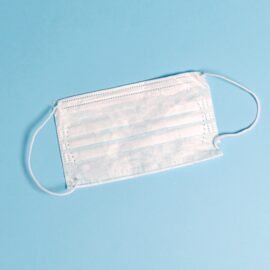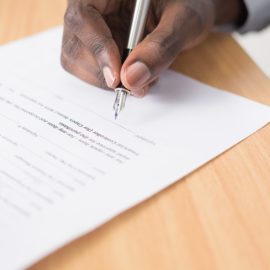

This article is an excerpt from the Shortform book guide to "The Oxygen Advantage" by Patrick McKeown. Shortform has the world's best summaries and analyses of books you should be reading.
Like this article? Sign up for a free trial here.
What is a carbon dioxide tolerance test? How can you increase your carbon dioxide tolerance?
In The Oxygen Advantage, Patrick McKeown recommends regularly testing your carbon dioxide tolerance to track how healthy your breathing habits currently are. If your test shows you need improvement, you can follow our basic training exercise for help.
Read below to learn how to perform a carbon dioxide tolerance test and get your breathing on the right track.
How to Test Your Carbon Dioxide Tolerance
McKeown recommends performing a carbon dioxide tolerance test to track how healthy your breathing habits currently are. The breathing exercises that McKeown recommends vary depending on your current CO2 tolerance, so testing it helps you know which exercises to include in your routine. Tackling intense breathing exercises before your body is ready will tire you out quickly with minimal benefits, and trying and failing at these exercises will only discourage you from sticking with the program.
To test your carbon dioxide tolerance, take a normal breath; then, at the end of your exhale, plug your nose and hold your breath. Time how long it takes before you first feel the need to breathe (not how long you can hold out before you have to breathe).
This time represents how tolerant your body is to carbon dioxide, and it’ll increase as your tolerance increases. A typical adult who exercises frequently can go 20 seconds before feeling the need to breathe, but McKeown recommends training your body until you can make it to 40 seconds to achieve peak physical fitness.
For the most accurate assessment, perform this exercise immediately after waking up. Your unconscious breathing while asleep will be the same every night, putting your respiratory system in a neutral state and ensuring that your test will be consistent and objective.
| Use Carbon Dioxide Tolerance to Gauge Physical Recovery Other than McKeown’s test, the most popular method of testing your tolerance to carbon dioxide is one created by free divers training to hold their breath longer. Andrew Huberman has more recently refined and popularized these divers’ carbon dioxide tolerance test. He uses the test to enhance fitness training in a different way. While McKeown uses CO2 tolerance as a long-term metric that measures which exercises you’re fit enough to benefit from, Huberman uses CO2 tolerance as a short-term metric that measures how well your nervous system has recovered from recent exercise. Huberman’s test is also unlike McKeown’s in that it doesn’t measure your body’s desire to offload carbon dioxide (the feeling that you need to breathe). Instead, it measures your ability to control the diaphragm and activate the parasympathetic nervous system in the presence of carbon dioxide. According to Huberman, this is a direct indicator of how well your nervous system has recovered from exercise, which helps you avoid pushing your body past its limits. To do this test, inhale through your nose and exhale through your mouth, slowly and deeply, four times in a row. Then, take one big diaphragmatic inhale, purse your lips, start a timer, and exhale through your mouth as slowly as you’re able to. As with McKeown’s test, stop the timer when you’ve run out of breath to exhale—not when you feel a need to inhale. Like McKeown, Huberman recommends doing this test first thing in the morning. If your exhale lasts 30 to 60 seconds, your nervous system has recovered to a sufficient degree for further exercise. A full 120 seconds generally indicates that your body is performing at the highest possible level. However, if your exhale lasts less than 25 seconds, it indicates that your nervous system is still recovering from recent exertion, and you should give yourself time to rest or enhance recovery in some other way before engaging in more physical training. |
Basic Carbon Dioxide Training
The core exercise you’ll use for carbon dioxide tolerance training is a breathing procedure you can do while sitting or lying down (McKeown calls this the “Breathe Light to Breathe Right” exercise). If your carbon dioxide tolerance time is 15 seconds or more, you’ll typically be able to complete and benefit from this exercise. McKeown recommends practicing this for 10 minutes, three times a day.
Place one hand on your chest and one hand on your belly. Breathe slowly and deliberately with your diaphragm—the hand on your belly should move while the hand on your chest remains relatively still. Press into your body with your hands, physically pushing against the breath as you inhale. The goal here is to reduce the amount of air you breathe in—with every breath, inhale less air until you’re breathing far less air than you typically do. If you feel like you’re breathing less than your body wants you to, you’re successfully training your carbon dioxide tolerance.
When performing this exercise, relax your body—none of your muscles should feel tense. If you ever feel yourself involuntarily tense up or your breathing becomes jerky and unstable, take a break—the goal is smooth, easy breathing that slightly challenges your desire to breathe. If you struggle to achieve this, you may need to build some carbon dioxide tolerance before adding this exercise to your routine. You can use nasal breathing and the breath reset exercise described above to do so.
(Shortform note: If you struggle to relax your body during this exercise, try using a technique called progressive muscle relaxation. Some experts assert that by tensing one part of your body at a time for four seconds and then releasing this tension, you neutralize your body’s stress response and experience full-body relaxation. This will automatically slow your breathing, theoretically making it a valid way to increase your carbon dioxide tolerance in itself. If McKeown’s training exercise is too challenging at first, this may be a good place to start.)
| Comparing McKeown’s Exercise to Pranayama McKeown’s diaphragmatic breathing exercise is nearly identical to one prescribed by yoga practitioners. In the ancient yogic tradition, disciplined breathwork is called pranayama, and practitioners use it to control the essential energy of the universe, called prana. Modern practitioners use pranayama for spiritual growth as well as more general health benefits. Like McKeown, modern pranayama practitioners recommend sitting or lying down, placing one hand on your chest and another on your belly, and intentionally breathing into your diaphragm. Additionally, some experts recommend placing a light sandbag on your stomach while you practice this exercise, applying a more consistent pressure than the forceful palms McKeown suggests. They specify that this pressure helps strengthen your diaphragm and abdominal muscles, making it easier to breathe in a healthy way. Yoga experts also provide an alternative technique for people who struggle with basic diaphragmatic breathing: the crocodile pose. Lie on your belly and rest your head on your crossed arms so your stomach is slightly lifted off of the floor. This pose makes it easier to ensure you’re breathing diaphragmatically—when you feel your stomach touch the floor, you know you’re inhaling into the diaphragm successfully. If your carbon dioxide tolerance is low and you have a hard time understanding what diaphragmatic breathing feels like, consider starting with this exercise. Some yoga experts recommend practicing pranayama in sessions that last at least 15 minutes and as frequently as 10 times a day. |

———End of Preview———
Like what you just read? Read the rest of the world's best book summary and analysis of Patrick McKeown's "The Oxygen Advantage" at Shortform.
Here's what you'll find in our full The Oxygen Advantage summary:
- How proper breathing can help you lose weight, sleep better, and more
- How modern living conditions cause people to breathe too much
- Training exercises to help you breathe less and build CO2 tolerance






